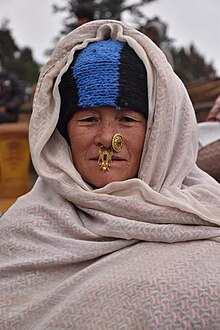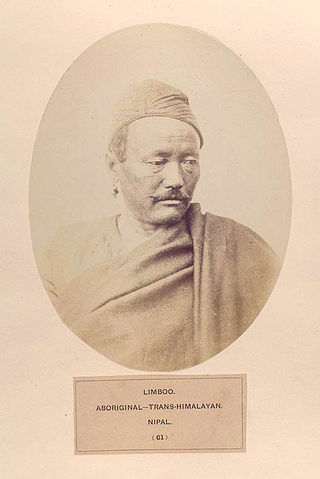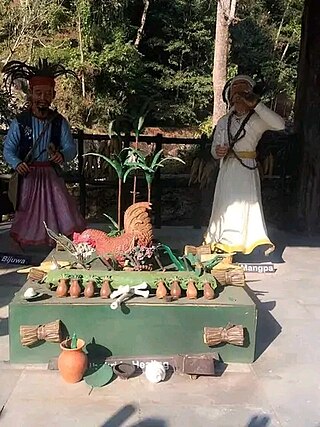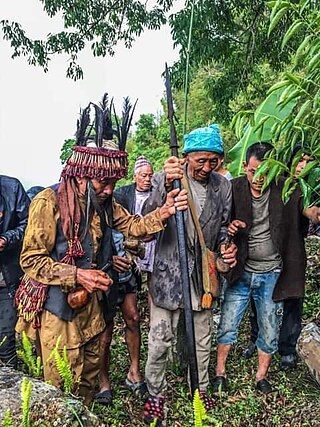ᤖᤠᤀᤡ राई | |
|---|---|
 A Rai women in traditional Nose Ring(Dhungri-Bulaki) | |
| Total population | |
| c. 1.1 million • | |
| Regions with significant populations | |
| • •Koshi Province :506,422 •Bagmati Province:112,364 •Madhesh Province:10,210 •Gandaki Province:7,599 •Lumbini Province:2,628 •Sudurpashchim Province:917 Karnali Province:534 • •West Bengal :300,000 (estimated) [5] •Sikkim:77,954 (2006) 13.04% of total Sikkimese Population [6] •Assam and other Northeastern States:NA •Bihar:1000(above)few villages of Supaul and Madhepura subdivisions [7] • •Rai population mostly found Southern Bhutan and few numbers in Western and Eastern Bhutan | |
| Languages | |
| |
| Religion | |
| Predominantly: 65% Kiratism or Animism Other Religions: 30% Hinduism, 5% Christianity (2011) [9] | |
| Related ethnic groups | |
The Rai are ethnolinguistic group belonging to the Kirat family and primarily Tibeto-Burman linguistic ethnicity. [10] They mainly reside in the eastern parts of Nepal, the Indian states of Sikkim, West Bengal (predominantly Darjeeling and Kalimpong Hills) and in southwestern Bhutan. [11] [12]
Contents
- Geographical distribution
- Nepal
- India, Bhutan and other countries
- History
- Mythology of Rai People
- Kirat Dynasty in Kathmandu Valley
- Kirat Kingdom in the east
- Gorkhali conquest in Kirat country
- Culture
- Marriage system
- Death ritual
- Family and kinship
- Gender issues and decision-making procedure
- Attire and ornaments
- Religion
- Suptulung: Places of sacred worship
- Folk gods and goddesses
- Rai shamanism
- The Mundum
- Rai Tribes and Clans
- Rai Sub-communities or linguistics groups
- Clans of Rai Tribes/Sub- Communities
- Languages
- Festivals
- Sakela
- Nwagi
- Yele
- Other festivals
- Folk songs and dances
- Folk songs
- Folk dances
- Folk musical instruments
- Occupations
- Notable Rai people
- See also
- References
- External links


The Rai, as a set of groups, are one of the oldest tribes of Nepal. They inhabited the area between the Dudh Koshi and Tamur River in Nepal. They claim that their country called Kiratdesh in modern times, has spread over Nepal, Sikkim and West Bengal. [13] Rai are also known as "Khambu" and in some places, they are known as "Jimee" or "Jimdar". "Jim" means "land", which meant they owned the lands and other tribes had to pay their taxes to the jimdar, they started animal farming and agricultural vegetation as their traditional occupation. They are known for worshipping nature and ancestral spirits. H.H. Risley treats the Rai and Jimdar as synonymous with the Khambus, but most of the Rai nowadays do admit Khambu and Jimdar to be synonymous terms connoting the same ethnic group. Rai are one of the dominant tribes of the Kirati group; they are a fighting tribe of Nepal. They are popularly believed to have offered a stiff resistance to the invasion of the Gorkhas. [14] Kiranti Rai are hill tribes who once possessed considerable power and territory but were reduced to submission by Prithvi Narayan Shah after his conquest of Nepal. [15] Kirati rule in the eastern hills of Nepal ended after the conquest of the Gorkha Kingdom in 1772–1773. [16]



























